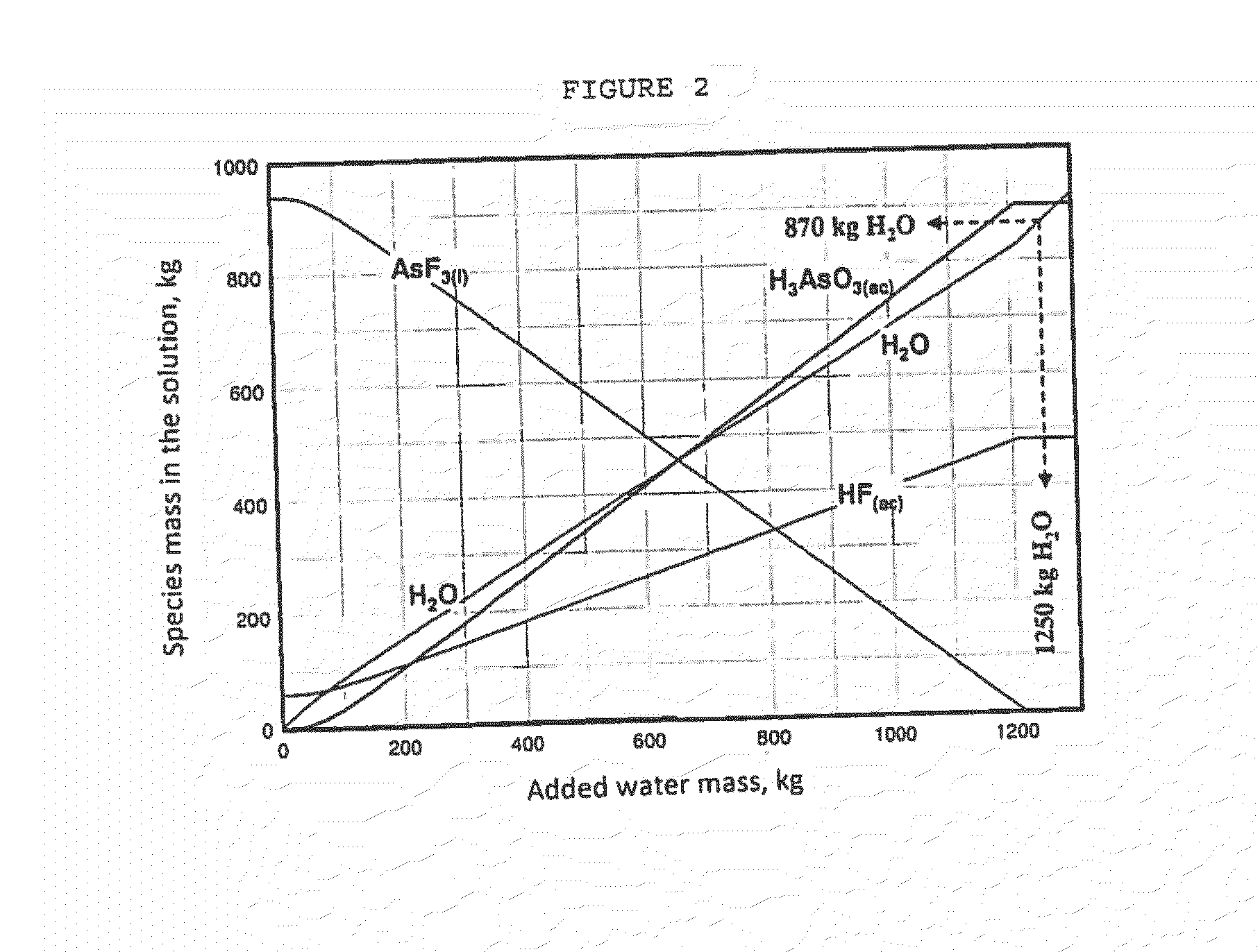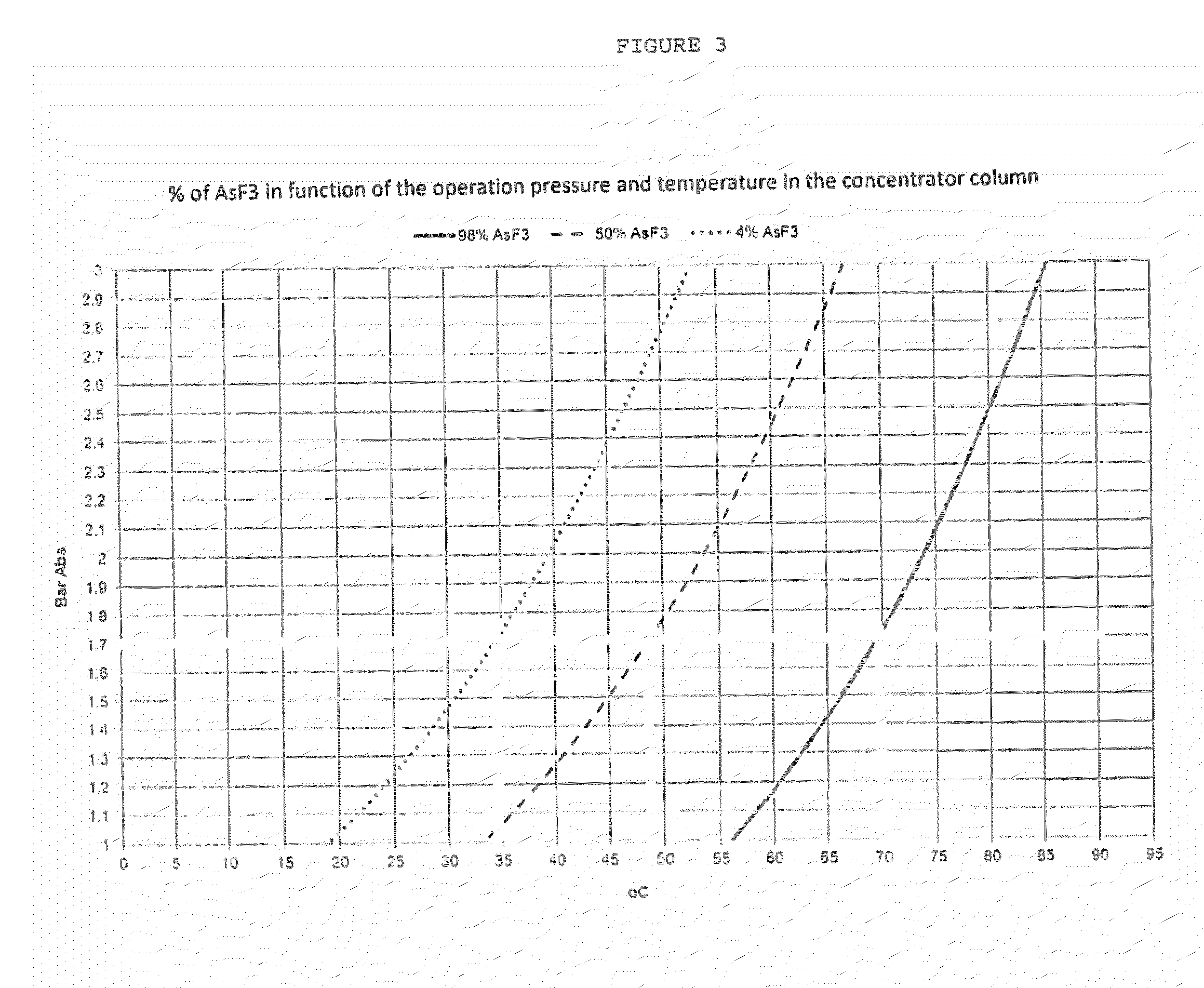Process for purification of hydrofluoric acid including obtaining arsenious acid by-product
a technology of hydrofluoric acid and arsenic acid, which is applied in the direction of arsenic oxide/hydroxide/oxyacid, inorganic chemistry, halogen/halogen-acid, etc., can solve the problems of unsatisfactory asf3 in hydrofluoric acid, damage to the integrity of the equipment exposed, and problems in the safety of operation
- Summary
- Abstract
- Description
- Claims
- Application Information
AI Technical Summary
Benefits of technology
Problems solved by technology
Method used
Image
Examples
example a
Integration of Hot Water System
[0107]Equipment: Two (2) cooling machines of 500 TR each, a reboiler to evaporate HF with 435.2 m2, a 100.6 m2 water heater, two (2) cooling towers of 500 TR each.
[0108]Operation: The water flow of the cooling tower is connected to the cooling machine (condenser side of the refrigerant). The output of the machine is connected to the water heater; the output of the water heater is connected to the re-heater that will evaporate the HF; the output of the re-heater is returned to the cooling towers and the pumps are started to recirculate water in this circuit.
[0109]Water vapor is fed to the heater in order to raise its temperature to about 36° C. to evaporate the HF. Once the cooling machines have thermal load in equilibrium, the temperature of the water leaving the condenser of the machines is sufficient to maintain itself the evaporation of HF in the re-heater, which can deviate the water flow to the steam heater and go directly to the cooling towers, l...
example b
Operation of the Concentrator Column
[0110]Equipment: 23.6 Meters height packed column, 11.6 square meters shell and tube condenser and 3.2 square meters tube and shell superheater.
[0111]Services: Ice water with a flow of 19.1 m3 / hr at 15° C. 15 psig steam with a flow rate of 196 kg / hr.
[0112]Operation. A flow of 90 kg / hr HF with about 40,000 ppm As is continuously fed. A backflow of 1 ton / hr is maintained, operating the column at a pressure of about 0.2 to 0.6 kg / cm2.
[0113]The column is purged until the bottom temperature rises to about 70-72° C., when it is operating at 0.7 kg / cm2, which means that AsF3 98% has been concentrated in the bottom. There are final temperatures for different operating pressures, which are shown in FIG. 3. The purge is transferred to a receiving tank and subsequently will be ready to be treated.
example c
Conversion of AsF3 Purge in Arsenous Acid
[0114]Equipment: About 2 m3 tank, a 10 m3 tank and a third 10 m3 tank.
[0115]Services: Wastewater with residual arsenic.
[0116]Operation: Whenever the concentrator column reaches 72° in the bottom, which means a concentration of 98% AsF3, it is transferred to the 2 m3 purge receiving tank, otherwise the dilution tank is prepared by filling the tank with water containing arsenic residues at 60% of its capacity, to later transfer the purge receiving tank to complete 100% of dilution tank level. In this ratio the entire AsF3 will have been hydrolyzed to H3AsO3 generating HF as by-product and excess water. A typical final hydrolysis composition will contain 40% H3AsO3, 40% H2O and 20% HF. The indicated values are given as examples but these will change depending on the dilution performed.
PUM
 Login to View More
Login to View More Abstract
Description
Claims
Application Information
 Login to View More
Login to View More - R&D
- Intellectual Property
- Life Sciences
- Materials
- Tech Scout
- Unparalleled Data Quality
- Higher Quality Content
- 60% Fewer Hallucinations
Browse by: Latest US Patents, China's latest patents, Technical Efficacy Thesaurus, Application Domain, Technology Topic, Popular Technical Reports.
© 2025 PatSnap. All rights reserved.Legal|Privacy policy|Modern Slavery Act Transparency Statement|Sitemap|About US| Contact US: help@patsnap.com



